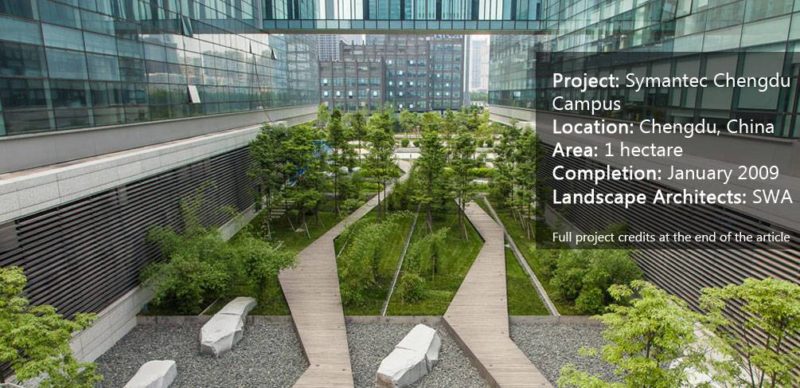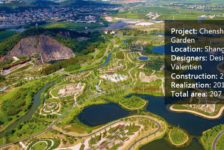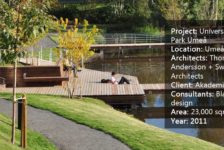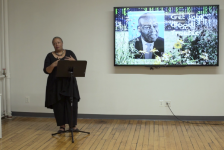Article by Radenka Kolarov – Total reading time 5 minutes. We already saw that China definitely has amazing projects in the article by Lidija Šuster. There is also one small but no less important project right in the center of the city of Chengdu. This Campus houses the office buildings and research facility of the company, Symantec, which has created leading technology innovations. SWA team is one of the world’s design leaders in landscape architecture, and their projects have garnered over 800 awards. That certainly tells a lot. TEECOM’s role was to design a converging network as a common platform for all systems and this brilliant data center design helps to reduce power and cooling demands. In the following article, I will do my best to present to you, this really special campus design.

Symantec Chengdu Campus. Photo credit: Tom Fox
It is important to emphasize that this design reinvigorated a formerly inactive area and links the components of the building program inside the campus. It represents a small oasis in the urban environment and focuses on sustainability as a guiding idea. The topic of ‘sustainability’ has been of great importance in recent years as well as today.
Symantec Chengdu Campus
Modern Design – Old Design Have you ever actually thought how interesting and different Chinese gardens, and alltogether its landscape design, are? At first sight, we can see that this campus doesn’t have much in common with historically famous Chinese gardens, but when you look at it closer, you will realize that all of those elements are perfectly inherent and integrated.
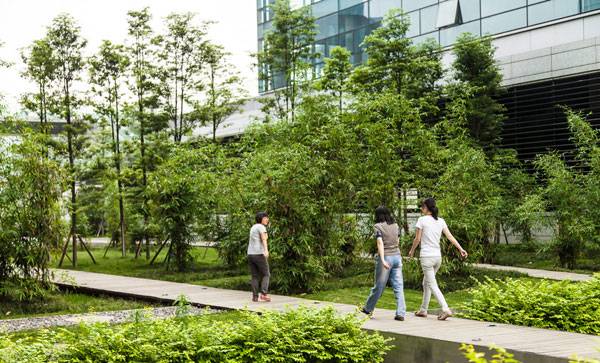
Symantec Chengdu Campus. Photo credit: Tom Fox
Let me show you some parallels that will easily give you an idea of exactly what I’m thinking about. In days of yore, the main objective of the ancient Chinese gardens was to establish a sense of isolation and privacy on small holdings. This principle is also respected in this project by putting it on only one hectare. The pictures belie the scale of the site, as it is much smaller than it appears. This is one of the reasons why this campus is so exciting and magical. The main design is based on the scheme which creates a “brocade” by weaving together the building, vegetation and paths. When all these things permeate each other, it forms an oasis amid the dense, urban location.
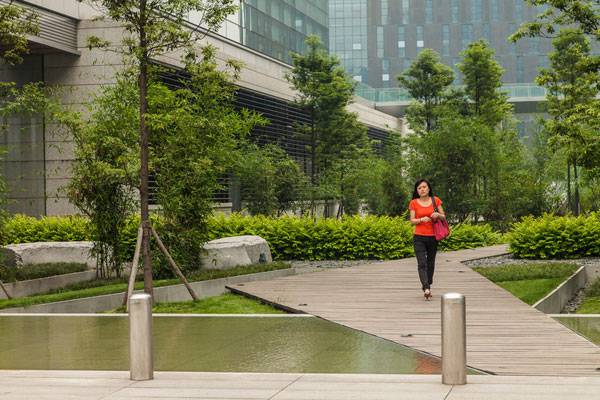
Symantec Chengdu Campus. Photo credit: Tom Fox
This garden’s vegetation is very beautiful and unique; it is based on a woodland community of different types of conifers which are young trees, and deciduous trees characteristic of Southwest China, such as bamboos, trees, and shrubs, which have very light leaves and give nice contrast within the composition. It provides us the feeling of finding ourselves in some kind of natural environment, with very little human impact, far away from the city. Everything is perfectly connected, even the stones that are the essential material in creating the gardens and its design, look like they have been there forever. Instead of some small lake or perhaps a stream, which were very characteristic for the gardens in the past, this campus has water mirrors between the paths and vegetation. The depth of only a few inches is enough for these water mirrors to provide us an outstanding view and an experience of relaxation within our personal space.
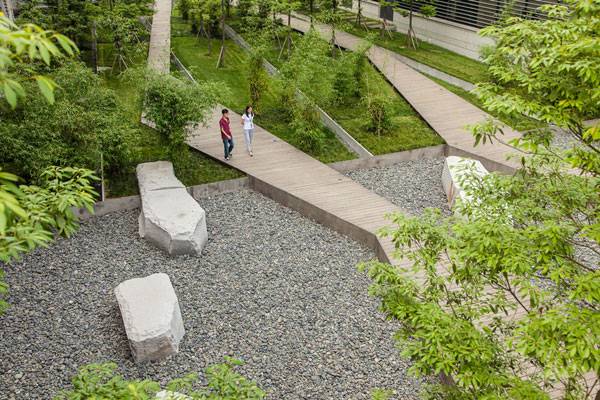
Symantec Chengdu Campus. Photo credit: Tom Fox
It is known that green oases in urban environments have purposes like reducing the summer temperatures, cleaning the air, reducing harmful pollutions created by traffic, and perhaps in some cases mitigating the blowing of the wind. The above-mentioned characteristics are exactly the ones that Symantec Chengdu campus provides. Also, the esthetic experience of a space like this can and will give us a complete feeling of relaxation and resting, or maybe a sense of feeling better after merely walking by various trees. Besides the really strong graphic quality of the ground plane, this campus has highly integrated programming on the rooftop space with an extensive site-wide storm water discharge garden, all with the purpose of draining the extensive amount of runoff that comes from the stormwater and irrigation systems. It connects the buildings and site, and creates functional and environmentally sensitive urban outdoor space. Yet, it looks like a space for itself, cut from a small hill, or monticule, and wreathed with paths made of wood.
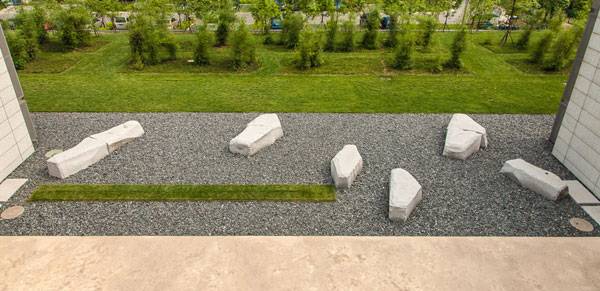
Symantec Chengdu Campus. Photo credit: Tom Fox
Those paths are very characteristic, especially for this campus, because of their curvilinear position which enables walking in both directions and the pastel color, which adds even more to the harmonious ambiance. If I would have an opportunity to walk through this campus every day, I’m sure that I would never miss that part! Would you? For sure, it also breaks the monotony of its environment and, as seen through the building’s windows surrounding the campus, it represents the main point of view, the focus, from any angle, of one very practical and lavishly planned place.
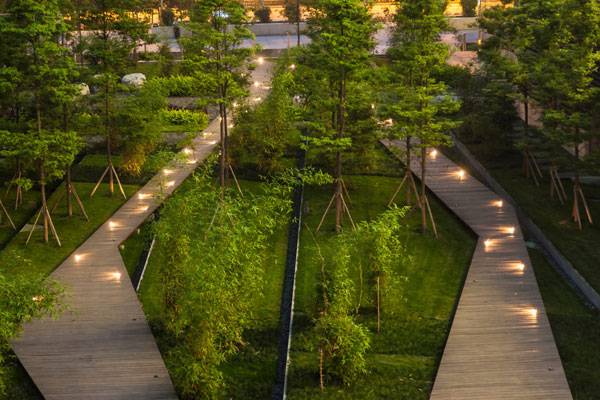
Symantec Chengdu Campus. Photo credit: Tom Fox
…our campus gets even more charming and magical. In a very simple but interesting way, soft LED lights are installed inside the wooden paths. In contrast with the conifers and small bushes, this LED lightning solution creates an atmosphere and ambience of pleasant relaxation during the nighttime. Symantec Chengdu campus is a project by the SWA land architecture team in the city of Chengdu. By its local position, it represents a mini-oasis in a very urban and developed city. It is made of natural Chinese elements that were also used in the gardens of China’s past. That is exactly the main reason why this campus is so good; functional and beautiful at the same time. With the very modest influence of new materials and the wise choice of new technologies, alltogether this represents a very clever and promising campus design.
Would you like to have a campus like this, perhaps in your city? Let us know in the comment section below! Go to comments 
Symantec Chengdu Campus. Photo credit: Tom Fox
Full Project Credits For the Symantec Chengdu Campus:
Project Name: Symantec Chengdu Campus Location: Chengdu, China Area: 1 hectare Completion: January 2009 Landscape Architects: SWA Photos: Tom Fox Recommended Reading:
Article by Radenka Kolarov
Published in Blog









